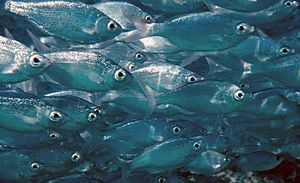Reticulated flagtail facts for kids
Quick facts for kids Reticulated flagtail |
|
|---|---|
 |
|
| Scientific classification | |
| Synonyms | |
Synonyms_ref = |
The reticulated flagtail, also known as the zebra-headed flagtail or Hawaiian flagtail, is a type of fish called a ray-finned fish. Its scientific name is Kuhlia sandvicensis. This fish belongs to the Kuhliidae family, often called "flagtails." You can find it in the middle part of the Pacific Ocean. People like to catch it for sport, and sometimes it's kept in aquariums.
Contents
What Does the Reticulated Flagtail Look Like?
This fish has a rather small eye. The top of its head is mostly straight. Its tail fin, called the caudal fin, is deeply forked, like a "V" shape.
The third spine in its anal fin (the fin on its belly near the tail) is a bit longer than the second one. These fish are shiny silver. They have a cool silver and black net-like pattern on top of their heads. The edge of their tail fin is also dark, almost black.
The fin on its back, called the dorsal fin, has 10 stiff spines and 11 or 12 soft rays. The anal fin has 3 spines and 11 or 12 soft rays. The reticulated flagtail can grow up to about 25 centimetres (9.8 in) long.
Where Do Reticulated Flagtails Live?
You can find Kuhlia sandvicensis in the Pacific Ocean. They live around places like Hawaii, Pitcairn Island, Tuamotu, Wake Island, Rapa, the Society Islands, and Kiribati.
Habitat and Biology
In Hawaii, young reticulated flagtails are very common. You can often see them along rocky shores and in tide pools. They also live in and around the mouths of streams that connect to the sea.
Young flagtails are often found under docks. They also like larger tide pools, and even ponds and streams that have both fresh and salty water. Adult flagtails prefer caves in coral reefs where waves crash. They also live in the surf zone at the bottom of cliffs and even in old shipwrecks. Sometimes, they swim together in groups in open water.
Even though these fish live in both ocean and freshwater, they do not need freshwater to complete their life cycle. They eat smaller fish, tiny water creatures without backbones, and insects.
How Scientists Learned About This Fish
For a long time, people thought Kuhlia sandvicensis was only found in Hawaii. They also believed it was the only type of flagtail fish there. But in the 1990s, fish scientists, called ichthyologists, noticed something interesting. They saw two different kinds of flagtails. One had a black and white "zebra pattern" on its head. The other had a plain head.
Scientists found out that the plain-headed fish was actually a different species, Kuhlia_xenura. They also learned that the zebra-headed flagtail was found in many places across the Pacific. The plain-headed one was the true Hawaiian species.
Reticulated Flagtails in Hawaiian Culture
In Hawaii, the grown-up fish is called ʻāhole. The young fish is called ʻāholehole. This name might come from the Hawaiian word hole, which means "to strip away." This is because the fish was used in ceremonies to "strip away" bad spirits. Sometimes, it was also called puaʻa kai, which means "pig of the sea."
Early European visitors were sometimes called ʻāhole because of their pale skin. The ʻāholehole was an important food fish for Hawaiian people. They often used it in their traditional ceremonies.
The place where Kona International Airport is now, Keāhole Point, is named after this fish. This is because many of these fish were found in that area.

